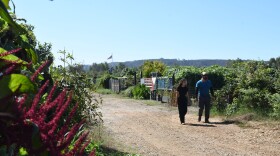San Diego poet Patrick Coleman writes about adversity and triumph in his Berkshire Prize-winning book "Fire Season.”
Coleman said his inspiration for the poetry in the book was the anxieties surrounding "surviving a California economy and a new career," the birth of his daughter and living in an area prone to wildfire.
Coleman lives in Ramona, in an area burned by the Witch Creek Fire in 2007.
"The way this landscape can turn on you in just an instant, does feel like a metaphor for having a new baby and you're worried about her health and so many things in our lives. I mean are days aren't guaranteed and anything can happen tomorrow," he said.
Coleman will be speaking about his book of prose Thursday at 7:30 p.m. at The Book Catapult in South Park.
He joins Midday Edition Thursday to discuss the inspiration for the book.
This is KPBS midday edition. I'm Maureen Cavanaugh and I'm Jade Hindmon. Patrick Colman takes us on a voyage through the stages of adversity. Uncertainty and triumph in his Berkshire Prize winning debut book fire season. He'll be speaking about his book of prose tonight at the book catapult. But first he joins us here on Midday. Patrick thanks for stopping and thank you for having me. Now what was the inspiration for the poetry and fire season. The inspiration really is. You know I live in Ramona and at the time I was working at the San Diego Museum of Art I had a brand new baby. And the way you are when you have a new child you're exhausted and when you're trying to survive a California economy and a new career is pretty exhausting. And the home that we live in is in a neighborhood that burned in the Witch Creek Fire of 2007. And so all these anxieties were kind of swirling around. And I also had no time to try to create something to express those except for in the car. And so I got a tape recorder and started to just talk outloud on the drive to and from the art museum. And I did that for two years and then transcribed everything and ended up with with this book. Wow. Can you read one of the poems that sort of captures that inspiration. Sure I'd be happy to. This is the first poem in the book called fire season in the grasslands. They put an airport. There's always a good reason. The grasses are dry. Golden around the coyote's late summer on the drive to work exhausted. I see two large white plains heavy bottomed boat like pass low on the tail and fuselage or wide orange stripes. They're going to drop water on the wildfires. The wildfires that rained ash over 50 miles onto the hood of my car the hood of my car that was up to keep the rats from chewing the wires the wires that they've chewed. Anyways my wife saw the fire start from where she nursed on the couch. The lightning of a summer thunderstorm that came in from the desert struck the mountain ranges over this is Southern California. We have a baby. There's always a fire somewhere and we spend our days pacing out the distances between there and now that really captures the anxiety the uncertainty the unknown. Your book is described as a search for gratitude among reasons to be afraid and proof that a person can pass through the fires and come out on the other side alive. Only a person who's been through the fire can approach this with such wisdom. So tell me about your fire and where you found gratitude in that. The funny thing is that we moved into this neighborhood in 2011 so the fire had already come and gone. My in-laws lived there and we saw it firsthand through them. And so this was always a kind of loose anxiety in the back of my mind and one of the quirks of the neighborhood is that there's only one way in or out. So it was very easy to feel like you could be trapped by a fire. And of course you know with the camp fire very recently that's exactly what happened it's the nightmare come to life. So it's been disturbing to see these vague anxieties I had while writing these poems come to pass for so many people in our state. And you know in reading your poems can fire just be looked at as a metaphor for a trial. I ended up thinking about fire as a metaphor a lot. And as a real thing and you know living where we do we're in the Romona grasslands area it's beautiful landscape I see bald eagles on the way to work. But the same things that you love about it. The chaparral you know another person might call that fuel and it is fuel for fire. And the way that this landscape can turn on you in just an instant does feel like a metaphor for having a new baby and you're worried about her health and so many things in our lives. I mean our days aren't guaranteed and and anything can happen tomorrow. Living in a in a region prone to fire does start to shape the way you see the world. Sometimes in good ways and also in lots of bad ways. But all real ways but all very real ways yes. Now in the book there is a piece of art next to each poem. Why did you decide to do that. So during this period I was a junior curator at the San Diego Museum of Art and was working with a lot of paintings and sculpture and was thinking about how when we look at a work of art some part of our perception is changed so I can clearly remember studying this Indian miniature painting and then seeing an echo of that landscape in that painting on the drive home looking at the San Diego back country at the same time that I was you know I'd stare at my daughter's face so intensely that on the drive to I would I would see her face in the mountains and this funny way that our perceptions are kind of immutable through the things that we take in through the media and our life experiences. And there was a kind of echo in that too of thinking about fire and thinking about the possibility of fire that lurks underneath the region that we love and take for granted. Interesting and each piece of art that you chose really does sort of complement the work. So how did you choose the art. Well first thank you. That's good to hear. And so some of them were. I was thinking about them while I was speaking the poems out loud. Other ones were ones that were on my mind and had an interesting resonance so this all happened in that month period where I transcribed everything at the end of two years of writing and just put them next to each other and really liked them that way and was just incredibly fortunate that the publisher found a way to keep them together. And you know there seems to be a message in your book about fire season sort of being a necessary time that moves us to birth renewal and then back to fire again. It's a cycle. What do you hope people will walk away with when reading your poems. That's a good big question. I think with anything that I write I would just hope that people feel less alone if they hear some echo of their own feelings in some of what what this is exploring and it's it's something that I think we're all thinking a lot about is how to how do we live in a state where fire season goes year round and what does that do to our state of being state of mind. And hopefully this is maybe a small contribution towards thinking about those things as part of larger plans to keep everyone safe. I've been speaking with Patrick Coleman author of fire season. He'll be speaking about his book of prose tonight at the book catapult at 730. Patrick thank you. Thank you very much.







